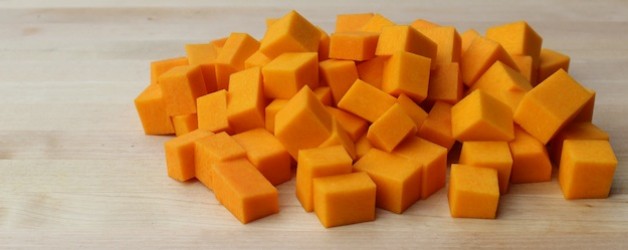

Butternut squash is a staple of our fall and winter menus. This bright vegetable brings a pop of color to any dish. It is a great side for meats or beans and is a sweet and delicious addition to soups or salads. Butternut squash is also a Super Food Dark Orange Vegetable; it contains vitamin C, potassium, iron, fiber, and is rich in the antioxidant beta-carotene. It is featured in many cuisines: Mexican (enchiladas), Italian (pastas), Indian (curry), American (soup). We’ve included butternut squash a number of times in posts because of its value and versatility. If it’s not already playing a starring role in your fall meals, here are good ways to add it now.
Butternut Squash Buying and Preparing
- Buying – Choose squash that are firm and heavy for their size. Make sure there are no soft spots or cracks. When buying butternut squash, look for ones with long necks since that will give you more usable flesh. *Speedy version: many stores sell pre-cut butternut squash in the refrigerated produce section, and you can also find bags of it in the freezer section.
- Storing – The thick skins on winter squash make them excellent for storing for about a month in a cool, dry place. Cooked squash can be frozen for several months.
- Cutting – Butternut squash have thinner skins and aren’t quite as difficult to tackle if you want to cut them before cooking. A vegetable peeler works well on a butternut squash if you’d rather not use a knife. For opening up thicker varieties before cooking, make sure you have a steady work surface and a large knife. You may try slicing just a little off the bottom to give you a flat surface to make the squash steadier. Use a kitchen towel to help you stabilize the squash as you split it open.
- Cooking – Butternut squash can be cooked a few different ways. They can be roasted whole, as described below, but they can also be steamed whole, or cut up and roasted.
- To roast whole, prick the surface a few times with a knife or fork after rinsing, then roast at 400 degrees F in a baking sheet or pan for about 30 minutes. Rotate the squash, then roast for another 15 minutes or so. Let cool, then cut in half. Scoop out the seeds, then the flesh.
- Steaming winter squash is also a great option, depending on the size of the squash. Just use a steamer insert so that the squash is not sitting in the water, and rotate after a ½ hour. It will take the same amount of time to steam as it takes to roast, although steaming will preserve more moisture in the squash. For that reason, it is a good choice for soups and purees.
- If cutting into pieces and then roasting, heat oven to 400 – 450 degrees F and cook for about 25-30 minutes or more depending on the size of the pieces. Pieces can be seasoned before roasting with olive oil, coconut oil, salt, pepper, curry, or maple syrup, depending on your recipe.
Five Fabulous Butternut Squash Recipes:
- Cubed Roasted Butternut Squash – our personal favorite and the most versatile – roast it! Use it alone as a side dish, add it to pasta sauce, top a salad with it, add it to a curry…there are so many possibilities.
- Warm Lentil Salad with Apples and Squash – loaded with Super Foods! Eat it warm or cold.
- Winter Squash Soup – top it with croutons or popcorn (kids think popcorn on soup is a blast).
- Skillet Hash – use butternut squash in place, or in addition to, potatoes in skillet hash.
- Roasted Butternut Squash Salad with Warm Cider Vinaigrette.
Happy November!
